maintenance AUDI S3 2012 Owners Manual
[x] Cancel search | Manufacturer: AUDI, Model Year: 2012, Model line: S3, Model: AUDI S3 2012Pages: 280, PDF Size: 70.11 MB
Page 6 of 280
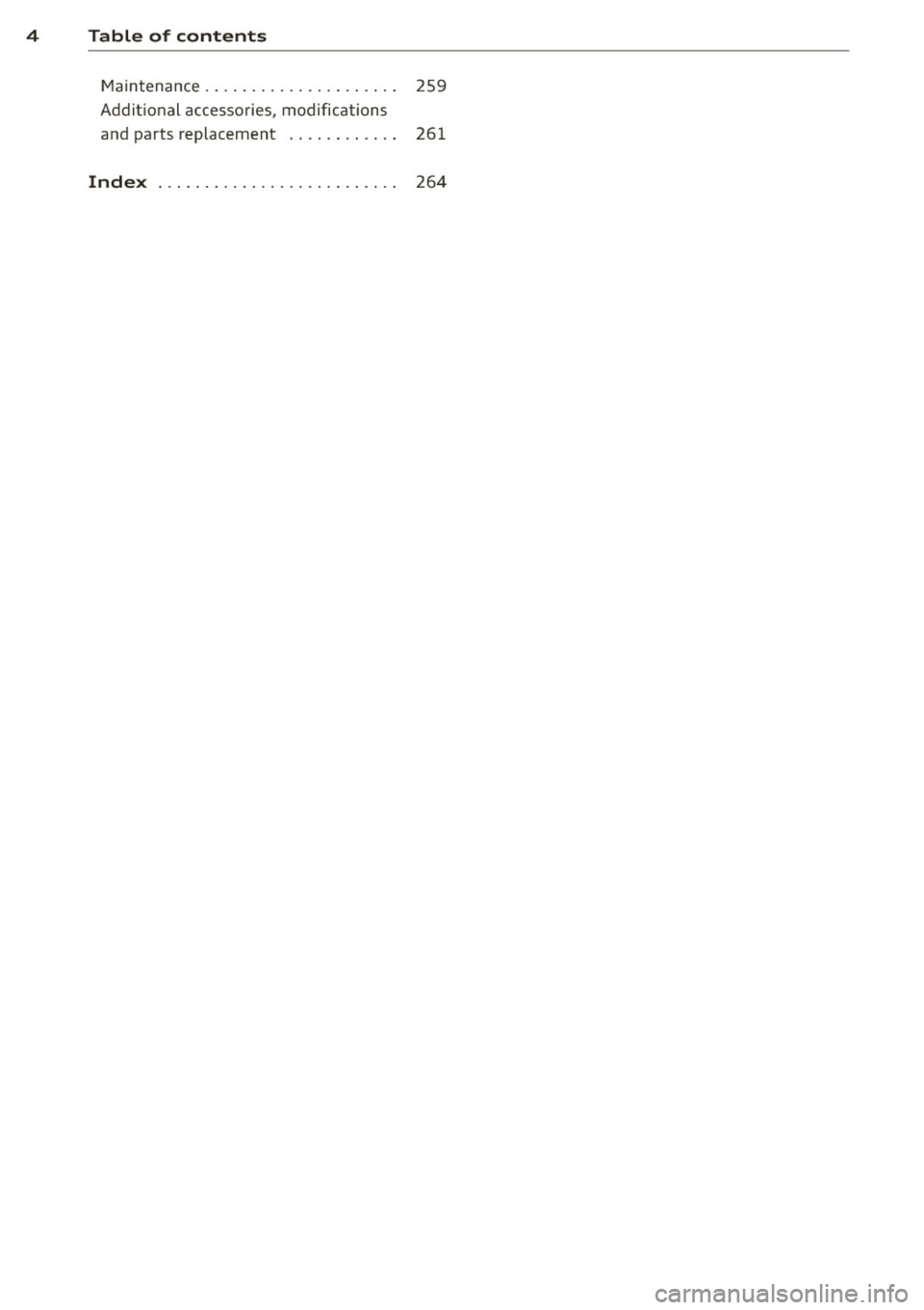
4 Table of contents
Maintenance . . . . . . . . . . . . . . . . . . . . . 259
Additional accessories, modifications
and parts replacement . . . . . . . . . . . . 261
Index ...... .. .......... .. .. .... 264
Page 7 of 280
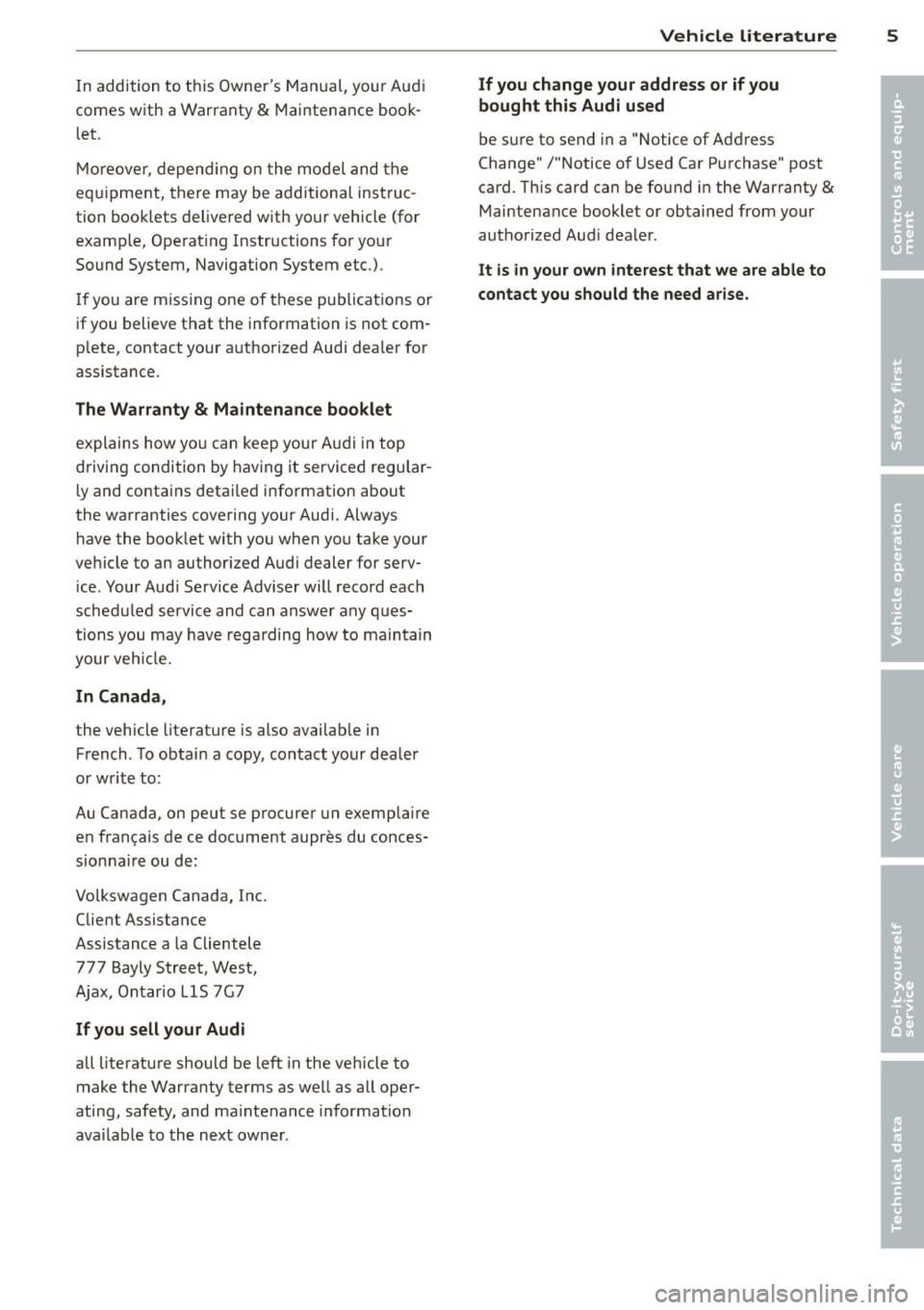
In addition to t his Owner's Ma nual, your A udi
comes w ith a Warranty
& Maintena nce book
l et.
Mor eover , d ep en ding on the mode l and t he
e quip ment, there may be additiona l ins truc
tion boo klets delivered w ith your vehicle (for
e x amp le, Ope rat ing Instr uctions fo r yo ur
Sound System, Navigation System etc .).
If yo u are m iss ing one of these publicat ions or
if you believe t hat the information is not com
p lete, contact your a uth orized Audi dea ler fo r
assistance .
The Warranty & Maintenance booklet
explains how yo u ca n keep your A udi in top
d riving condition by hav ing it serviced regular
l y and conta ins deta iled in fo rmation about
the wa rranties covering your Aud i. Always
h ave the book let with yo u when yo u take your
ve hicle to an auth orized Audi dealer for serv
i ce. Your Aud i Service A dviser w ill reco rd each
sche duled servic e and can answer any ques
tions you may have r ega rding how to ma intain
your ve hicle.
In Canada,
the vehicle lite rature is also avai lab le in
Fr ench . T o obtai n a co py, contact your dea ler
or w rit e to :
Au Canada, on peut se procure r un e xempla ire
e n fran<;ais de ce doc ument aupres du conces
sionna ire ou de:
Vo lkswagen Canada, Inc.
Client Assistance
Assistance a la Clientele
7 7 7 Bayly Street , West,
A jax, On tario llS 7G 7
If you sell your Audi
all literatu re should be left in the ve hicle to
make the Warranty terms as we ll as a ll oper
ating, safety , and ma intenance inf ormation
ava ilab le to the next ow ne r.
Vehicle literature 5
If you change your address or if you
bought this Audi used
b e s ure to send in a " Notice of A dd ress
Change" /" Notice o f Used Car Pu rchase" post
ca rd. T his card can be fo und in the War ranty
&
M aint enance booklet or obtained from your
a utho rized Aud i dea le r.
It is in your own interest that we are able to
contact you should the need arise .
•
•
Page 81 of 280

Warm and cold Climate controls
Description
The air conditioner is fully automatic and is
designed to maintain a comfortable and uni
form climate inside the vehicle .
We recommend the following settings:
... Se lect and set a temperature between 64 °F
(+ 22 °C) and 84 °F (+28 °C).
... Press the
!AU TO ! button.
With this setting, you attain maximum com
fort in the least amount of time. Change this
setting, as desired, to meet your personal
needs.
The climate controls are a combination of
heating, ventilation and cooling systems,
which automatically reduce humidity and cool the air inside your vehicle.
The air temperature, air flow and air distribu
tion are automatica lly regulated to achieve
and maintain the desired passenger compart
ment temperature as quickly as possib le.
The system automatically compensates for
changes in the outside temperature and for
the intensity of the sunlight entering the vehi
cle. We recommend you use the
Automatic
mode c> page 81 for year-round comfort.
Please note the following:
Turn on the air conditioner to reduce humidity
in the vehicle. This also p revent the windows
from fogging up .
When the outside temperature is high and the
air is very hum id,
condensation from the
evaporator may drip under the vehicle . This is
normal and does not indicate a leak.
If the outside temperature is low, the fan nor
mally only switches to a h igher speed once
the engine coolant has warmed up sufficient
ly.
Warm and cold 79
T he air conditioner temporari ly switches off
when you drive off from a standstill using full
throttle to save engine power.
T he compressor also switches off if the cool
ant temperature is too high so that the engine
can be adequately cooled under extreme
l oads.
Air pollutants filter
T he air pollutants filter (a combined particle
filter and activated charcoa l filter) reduces or
eliminates outside air pollution (dust, or pol
l en) from entering the vehicle .
T he air pollutants filter must be changed at
the interva ls specified in yo ur Warranty
&
Maintenance booklet, so that the air condi
tioner can properly work.
If you drive your vehicle in an area with high
air pollution, the filter may need to be
changed more frequently than specified in
your Audi Warranty
& Maintenance booklet. If
in doubt, ask your authorized Audi Service Ad
visor for advice.
Energy management
To prevent the battery from being discharged
and to restore the ba lance of energy, compo
nents which require large amounts of energy
are temporarily cut back or switched off c> page 167. Heating systems in particular re
quire a great deal of energy. If you notice, for
example, that the rear window heater is not
heating, then it has been temporarily cut back
o r switched off by
energy management.
These systems are available again as soon as
the energy balance has been restored.
_& WARNING
.-----
Reduced visibility is dangerous and can
cause accidents .
- For safe driving it is very important that
all windows be free of ice, snow and con-
densation.
- Fully familiarize yourself with the proper
use and function of the heating and ven
tilation system and especia lly how to de
fog and defrost the windows.
Page 173 of 280
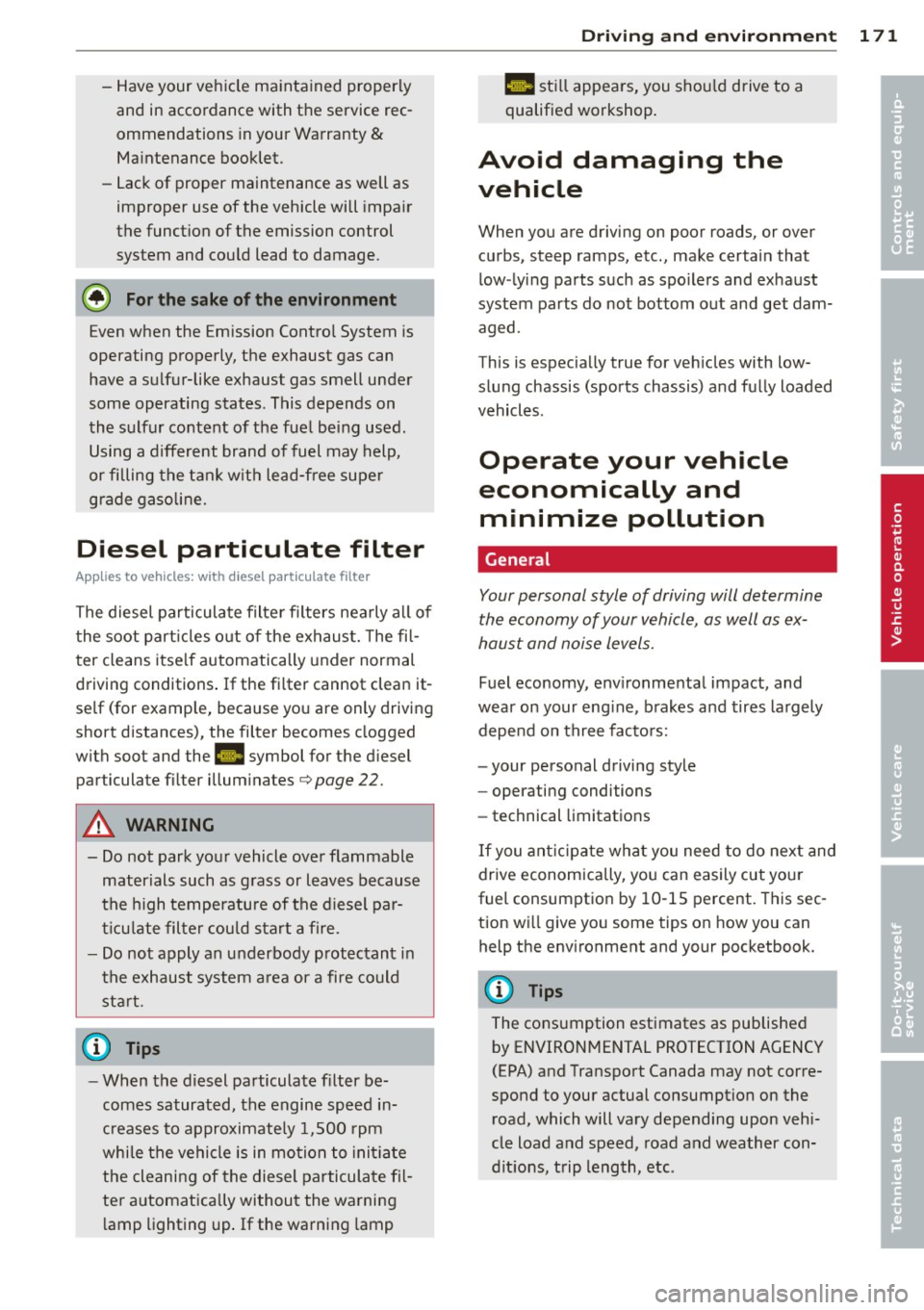
-Have your vehicle maintained properly
and in accordance with the service rec
ommendations in your Warranty
&
Maintenance booklet.
- Lack of proper maintenance as well as
improper use of the vehicle will impair
the function of the emission control
system and could lead to damage.
@ For the sake of the environment
Even when the Emission Control System is
operating properly, the exhaust gas can
have a sulfur-like exhaust gas smell under
some operating states. This depends on
the sulfur content of the fuel being used .
Using a different brand of fuel may help,
or filling the tank w ith lead-free super
grade gasoline.
Diesel particulate filter
Ap plies to vehicles: with diesel partic ul ate filter
The diesel particulate filter filters nearly al l of
the soot part icles out of the exhaust. The fi l
ter cleans itse lf automatically under normal
driving conditions . If the fi lter cannot clean it
self (for example, because you are only driving
short distances), the filter becomes clogged
with soot and the
II symbol for the diesel
particulate filter illuminates
c> page 22.
A WARNING
- Do not park your vehicle over flammable
materials such as grass or leaves because
the high temperature of the diesel par
t icu late filter could start a fire .
- Do not apply an underbody protectant in
the exhaust system a rea or a fire could
start.
(D Tip s
-When the diesel particulate filter be
comes saturated, the engine speed in
creases to approximate ly 1,500 rpm
while the vehicle is in motion to init iate
the cleaning of the diesel particulate fil
ter a utomatically without the warning
l amp lighting up . If the warning lamp
Dri vin g and en vironm ent 171
Ill sti ll appears, you shou ld drive to a
qualified workshop .
Avoid damaging the
vehicle
When you are driving on poor roads, or over
curbs, steep ramps, etc., make certain that
low -lying parts such as spo ilers and exhaust
system parts do not bottom out and get dam
aged.
This is espec ially true for veh icles with low
slung chassis (sports chassis) and fully loaded
vehicles.
Operate your vehicle
economically and minimize pollution
General
Your personal style of driving will determine
the economy of your vehicle, as well as ex
haust and noise Levels.
Fuel economy, env ironmenta l impact, and
wear on your eng ine, brakes and tires largely
depend on three facto rs:
- your personal driving style
- operating conditions
- technical limitations
If you ant ic ipate wha t you need to do next and
drive economically, you can easily cut your
fuel consumptio n by 10-15 percent . This sec
tion wi ll give you some tips on how you can
help the env ironment and your pocketbook.
(D Tips
The consumption estimates as published
by ENVIRONMENTAL PROTECTION AGENCY
(EPA) and Transport Canada may not corre
spond to your actual consumption on the road, which will vary depending upon vehi
cle load and speed, road and weather con
dit ions, trip length, etc.
•
•
Page 174 of 280
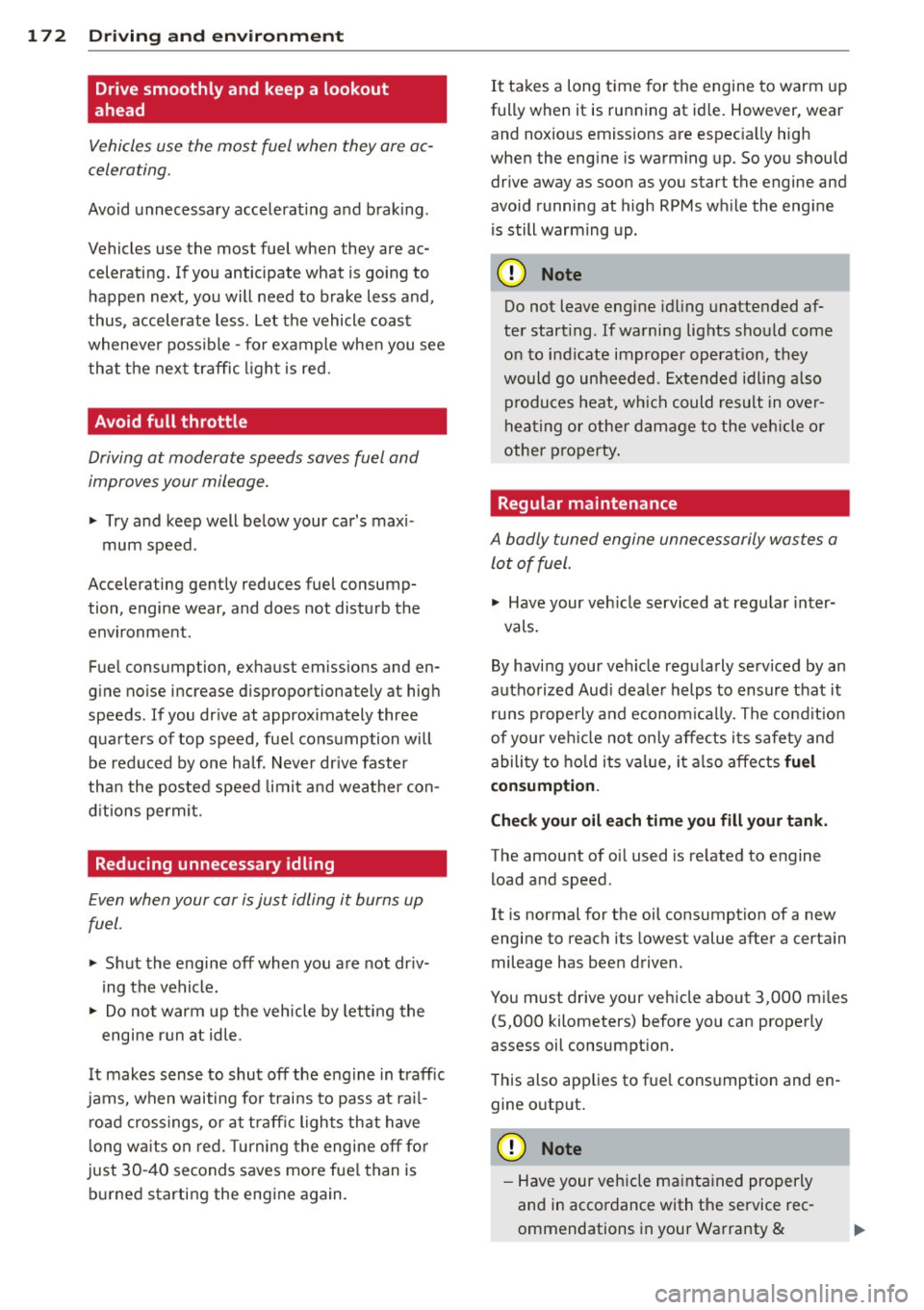
172 Driving and en vironm ent
Drive smoothly and keep a lookout
ahead
Vehicles use the most fuel when they are ac
celerating.
Avoid unnecessary accelerating and braking .
Vehicles use the most fuel when they are ac
celerati ng. If you anticipate what is go ing to
happen next, you will need to brake less and,
thus , accelerate less . let the vehicle coast
whenever poss ible -fo r example whe n you see
th at the next traffic ligh t is red.
Avoid full throttle
Driving at moderate speeds saves fuel and
improves your mileage.
,. Try and keep well be low your car's max i-
mum speed .
Accelerating gently reduces fuel consump
tion, engine wear, and does not disturb the
env ironment.
Fuel consumption, ex ha ust em issions and en
g ine no ise increase d isproportiona tely at hig h
speeds . If you dr ive at approximately three
qua rters of top speed, fuel consumption will
be reduced by one ha lf . Never dr ive faster
tha n the posted speed limit a nd weather con
d it ions permit.
Reducing unnecessary idling
E ven when your car is just idling it burns up
fuel.
,. Shut the engine off when you a re not dr iv
ing the vehicle.
,. Do not warm up the veh icle by letting the
engi ne run at idle.
It makes sense to shut off the eng ine in traff ic
jams, when waiting for trai ns to pass at ra il
road cros sings, or at t raffic ligh ts that have
l ong wa its on red. Turning the engine o ff fo r
just 30 -40 seconds saves more fue l than is
bu rne d starting the engine again.
It takes a long t ime for the engine to warm up
fully when it is running at id le . However, wea r
and noxious emissions are espec ia lly high
when the eng ine is wa rm ing up. So you shou ld
drive away as soon as yo u start the engine and
avo id running at high RPMs w hile the eng ine
i s s till warm ing up .
(D Note
Do not leave engine idling unattended af
ter start ing . If warni ng lig hts sho uld come
o n t o indicate improper ope ration, they
would go unheeded . Extended idli ng also
produ ces heat , w hich could result in ove r
hea ting or other dam age to the veh icle or
other property .
Regular maintenance
A badly tuned engine unne cessarily wastes a
lo t of fuel.
,. Have your ve hicle serviced at reg ular inter-
vals.
By havi ng your ve hicle regu larly serv iced by an
a utho rized Aud i deale r helps to ensure that it
runs properly and econom ica lly. The cond it io n
of your ve hicle not only affe cts i ts safety and
abili ty to ho ld i ts va lue , it al so a ffects
fuel
con sumption .
Check your oil each time you fill your tank .
The amount of oi l used is re lated to engine
load and speed .
It is normal for the oil consumption of a new
engine to reach its lowest value after a certa in
mileage has bee n driven .
You must drive your vehicle about 3,000 mi les
(S,000 kilometers) before you can properly
assess oil consumpt ion.
T his also app lies to fue l cons umption and en
gine o utp ut.
Q) Note
- Have your veh icle ma inta ined proper ly
and i n acco rdance with the service rec
ommendations in your Warranty
&
Page 175 of 280
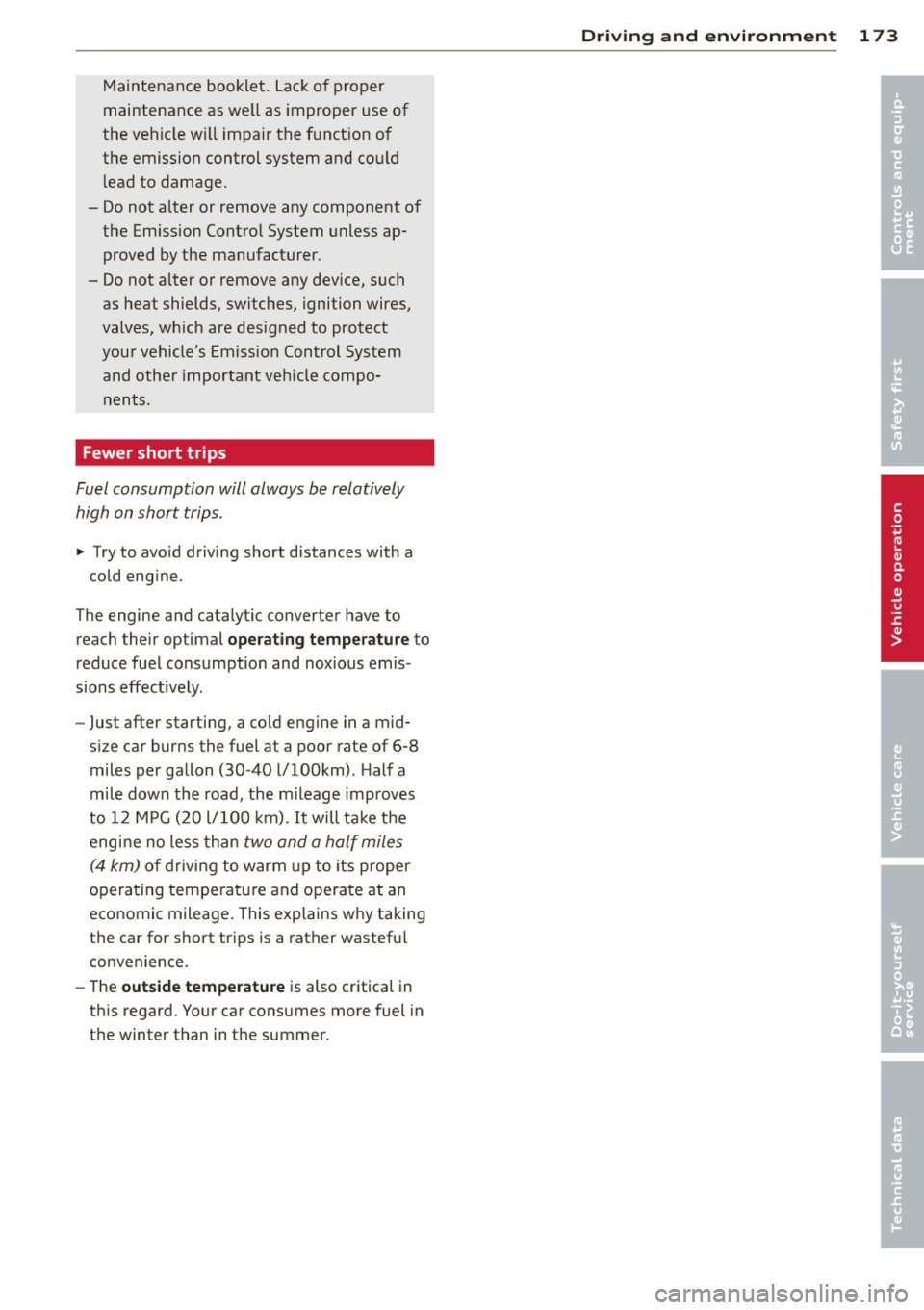
Maintenance booklet. Lack of proper
maintenance as well as improper use of
the vehicle will impair the function of
the emission control system and could lead to damage.
- Do not alter or remove any component of
the Emission Control System unless ap
proved by the manufacturer.
- Do not alter or remove any device, such
as heat shields, switches, ignition wires,
valves, which are designed to protect
your vehicle's Emission Control System and other important vehicle compo
nents.
Fewer short trips
Fuel consumption will always be relatively
high on short trips .
"' Try to avoid driving short distances with a
cold engine .
The engine and catalytic converter have to reach their optimal operating temperature to
reduce fuel consumption and noxious emis
sions effectively.
- Just after starting, a cold engine in a mid
size car burns the fuel at a poor rate of 6-8
miles per gallon (30-40 L/100km). Half a
mile down the road, the mileage improves
to 12 MPG (20 l/100 km).
It will take the
engine no less than
two and a half miles
(4 km) of driving to warm up to its proper
operating temperature and operate at an
economic mileage. This explains why taking
the car for short trips is a rather wasteful
convenience.
- The outside temperature is also critical in
this regard . Your car consumes more fuel in
the winter than in the summer.
Driving and environment 173
•
•
Page 178 of 280
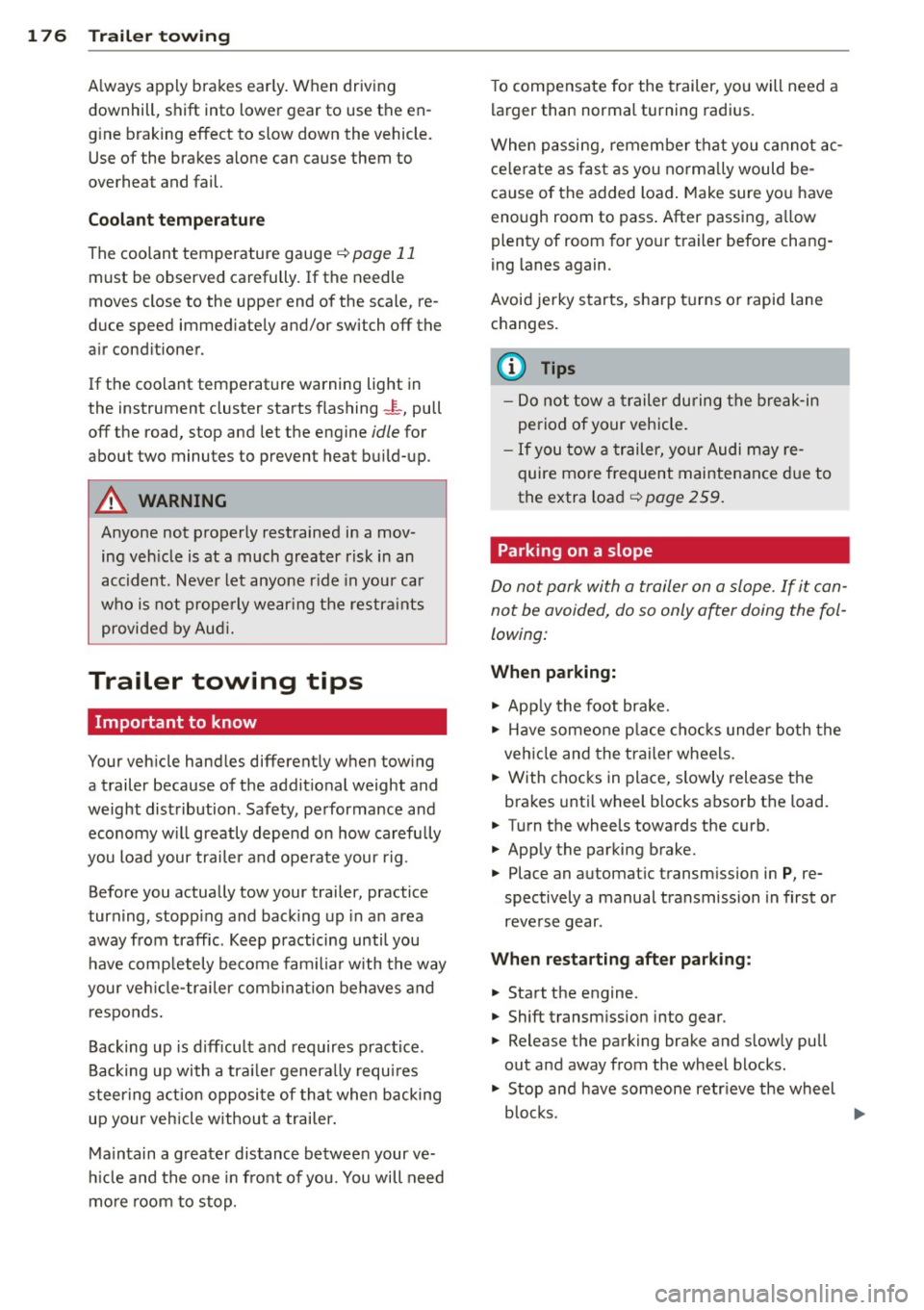
176 Trailer towing
Always app ly bra kes early . When driving
downhill, shift into lower gear to use the en
g ine braking effect to slow down the vehicle.
Use of the brakes alone can cause them to
overheat and fail.
Coolant temperature
The coolant temperature gauge ¢ page 11
must be observed carefully. If the needle
moves close to the upper end of the scale, re
duce speed immed iate ly and/or switch
off the
a ir cond itioner.
If the coolant temperature warning light in
the instrument cluster starts flashing
J_, pull
off the road, stop and let the engine idle for
about two minutes to prevent heat build-up.
A WARNING
Anyone not properly restrained in a mov
ing veh icle is at a much greater risk in an
accident . Never let anyone r ide in your car
who is not prope rly wear ing the restra ints
provided by Aud i.
Trailer towing tips
Important to know
Your veh icle handles different ly when towing
-
a trailer because of the addit io nal weight and
weight distribution . Safety, performance and
economy w ill greatly depend on how carefu lly
you load your trai ler and ope rate your rig .
Before you actually tow your trailer, practice
turn ing, stopp ing and back ing up in an area
away from traffic. Keep practicing until you have comp letely become fam iliar w ith the way
your ve hicle-trai ler comb ination behaves and
responds .
Backing up is d iff icu lt and requires practice .
Backing up with a tra ile r genera lly requ ires
steer ing act ion opposite of tha t when backing
up your veh icle without a trailer .
Ma intain a g reater distance between your ve
h icle and the one in fro nt of you. You will need
mo re room to stop. To compensate for the trailer, yo
u will need a
larger than normal turning radius.
When passing, remember that you cannot ac
ce le rate as fas t as you no rma lly would be
cause of the added load. Make sure yo u have
enough room to pass . After passing, a llow
plenty of room for your trailer before chang
ing lanes again.
Avoid jerky starts , sharp turns or rapid lane
changes.
(D Tips
- Do not tow a trailer during the break -in
period of your vehicle.
- If you tow a trailer, yo ur Audi may re
quire more frequent maintenance due to
the extra load ¢
page 2 59.
Parking on a slope
Do not park with a trailer on a slope . If it can
not be avoided, do so only after doing the fol
lowing:
When parking:
.,. App ly the foot brake.
.. Have someone p lace cho cks under both the
veh icle and the trailer wheels.
.. With chocks in place, slowly release the
brakes unti l wheel b locks absorb th e load.
.. Turn the whee ls towards the cu rb.
.. App ly the parking brake.
.. Place an automat ic transm ission in
P, re
spectively a manual transmission in first or
reverse gear .
When restarting after p ark ing:
.. Start the engine.
.. Shift transm ission into gear .
.. Release the parking brake and slowly pull
out and away from the wheel blocks.
.,. Stop and have someone retr ieve the wheel
b locks .
Ill-
Page 199 of 280
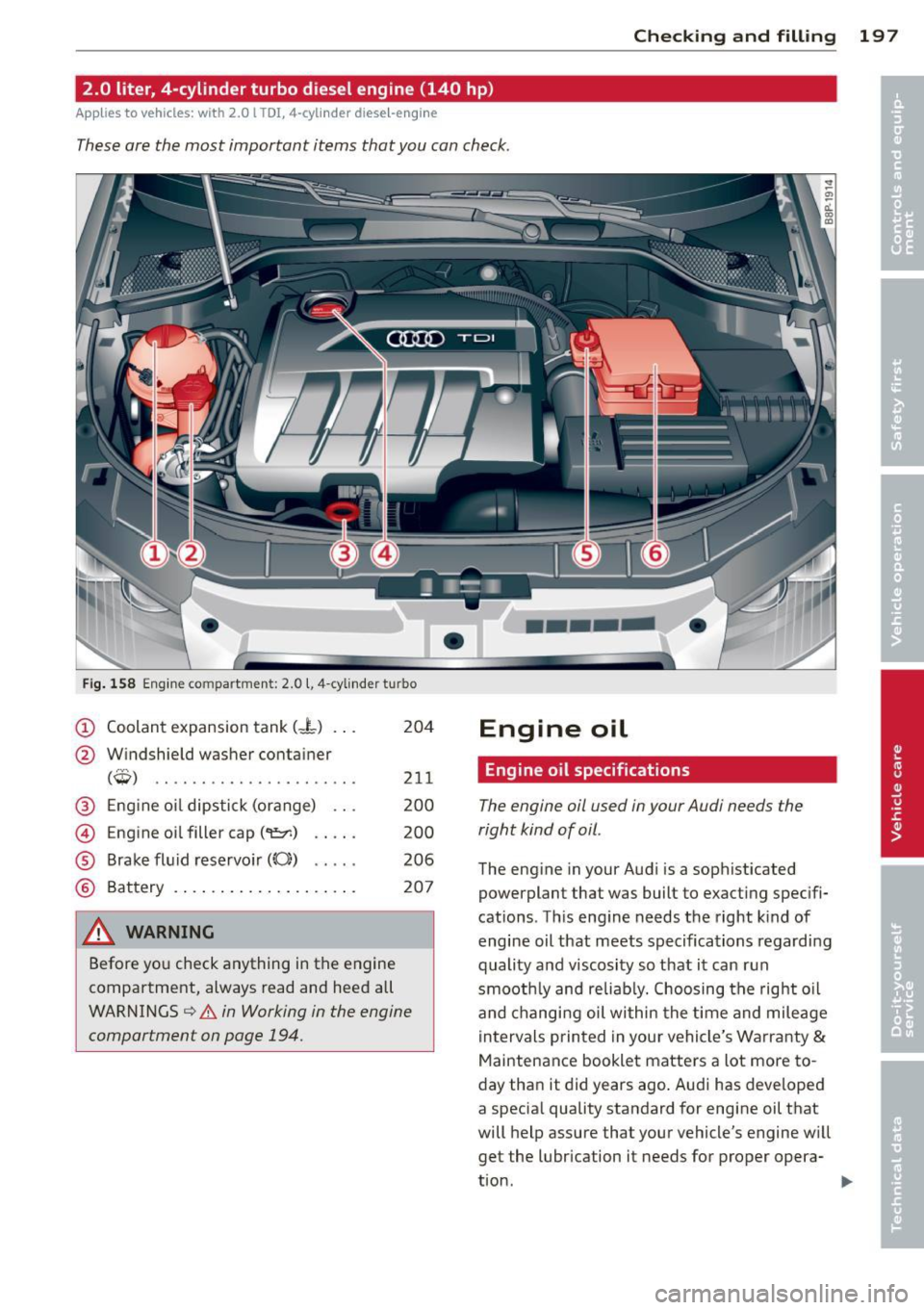
Checking and fillin g 197
2.0 liter, 4-cylinder turbo diesel engine (140 hp)
Applies to vehicles: with 2.0 l TOI, 4-cylinder diese l-engin e
These are the most important items that you can check .
Fig. 158 Engine compartment: 2.0 l, 4-cylinder tu rbo
(D Coolant expansion tank ( ... t) .. .
@ Windshield washer container 204
Cw)
.............. ...... . . 211
@ E ng ine oi l dipstick (orange) . . . 200
@ Engine oil filler cap ("t!::r.) . . . . . 200
® Brake fluid reservo ir ((0)) . . . . . 206
® Battery . . . . . . . . . . . . . . . . . . . . 207
A WARNING
Before yo u check anything in the engine
compartment, always read and heed all
WARNINGS ¢&. in Working in the engine
compartment on page 194.
-
Engine oil
Engine oil specifications
The engine oil used in your Audi needs the
right kind of oil.
The engine in your Audi is a sophisticated powerplant that was built to exacting specifi
cations . Th is eng ine needs the right kind of
engine oil that meets specifications regarding
quality and viscosity so that it can run
smoot hly and reliab ly. Choosing the right o il
and changi ng oil within the t ime and mileage
intervals printed in you r vehicle's Warranty
&
Maintenance booklet matters a lot more to
day than it did years ago . Audi has developed
a specia l quality standard for engine oil that
will help assure that your vehicle's engine w ill
get the lubr ication it needs for proper opera
tion.
Page 201 of 280
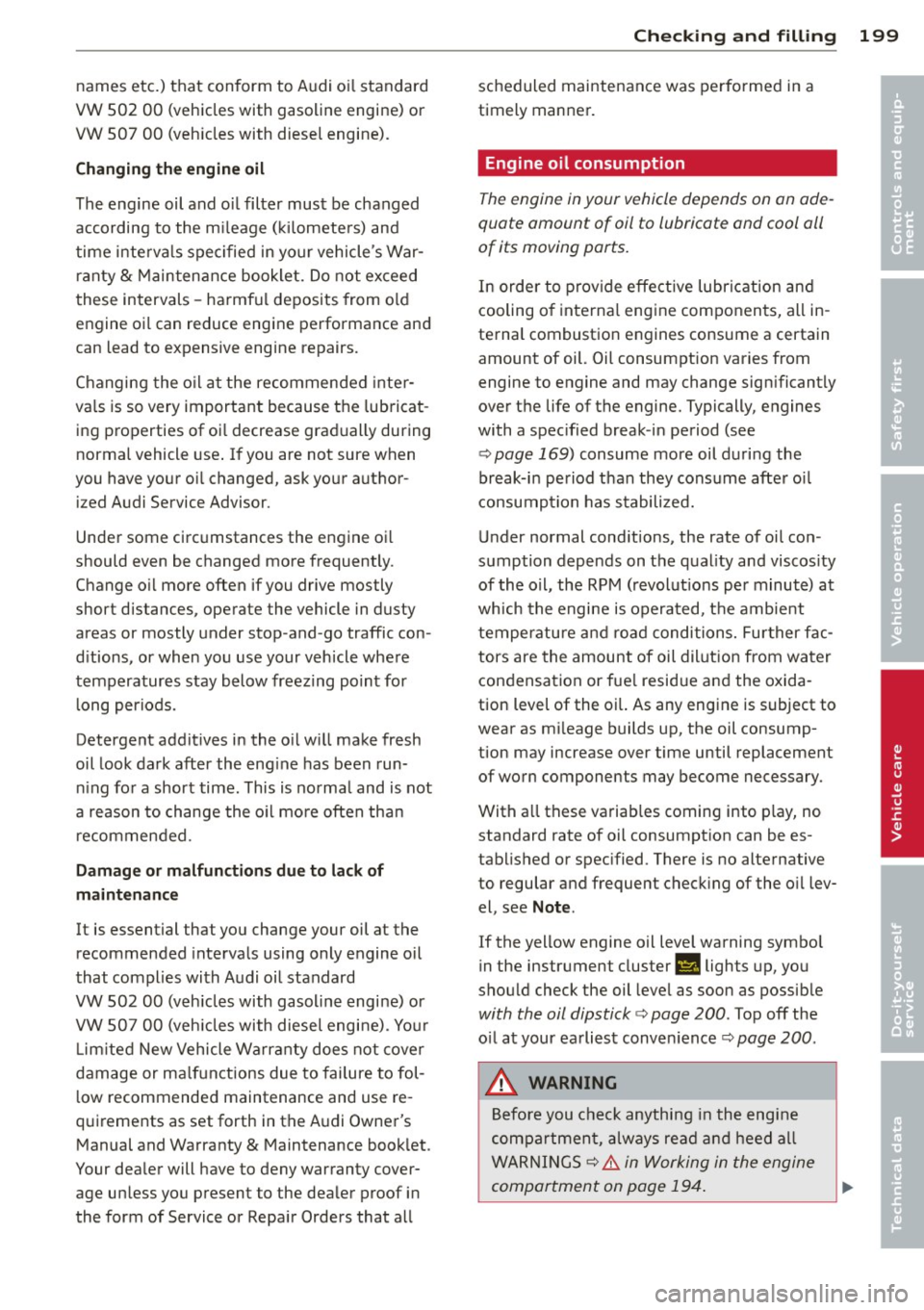
names etc.) that conform to Audi oil standard
VW 502 00 (vehicles with gasoline engine) or
VW 507 00 (vehicles with diesel engine).
C hang ing th e engin e oil
The engine oil and oi l filter must be changed
according to the m ileage (kilomete rs) and
time inte rva ls specified in yo ur vehicle's War
ranty
& Maintenance booklet. Do not exceed
these intervals -harmful deposits from old
engine oil can reduce engine performance and
can lead to expensive eng ine repairs.
Changing the o il at the recommended inter
va ls is so very important because the lubricat
ing properties of oi l decrease gradually during
norma l vehicle use . If you are not sure when
you have your oi l changed, ask your author
ized Audi Service Advisor.
Under some circumstances the engine oi l
should even be changed more frequently.
Change o il more often if you drive mostly
short distances, operate the vehicle in dusty
areas or mostly under stop-and-go traffic con
d itions, or when you use your veh icle where
temperatures stay below freezing point for
l ong periods.
Detergent addit ives in the o il w ill make fresh
oil look dark after the eng ine has been run
n ing for a short time. This is norma l and is not
a reason to change the o il mo re often than
r ecommended.
D amage or ma lf u nction s du e to lac k of
ma int enance
It is essential that you change your oil at the
recommended interva ls using only engine oil
that complies with Audi oil standard
VW 502 00 (veh icles with gasolin e engine) or
VW 507 00 (veh icles with diese l engi ne). Yo ur
L im ited New Vehicle Warra nty does not cover
damage or ma lfunctions due to failure to fol
l ow recommended maintenance and use re
quirements as set forth in the A udi Owner's
Manual and Warranty
& Maintenance book let.
Your dealer will have to deny warranty cover age un less you present to the dea ler proof in
the form of Service or Repa ir Orders that a ll
Checking and fillin g 199
scheduled maintenance was performed in a
timely manner.
· Engine oil consumption
The engine in your vehicle depends on an ade
quate amount of oil to lubricate and cool all
of its moving parts.
In order to prov ide effective lubrication and
cooling o f inte rna l engine components, all in
ternal combustion engines consume a certain amount of oil. Oil consumpt ion varies from
engine to engine and may change sign ificantly
over the life of the engine. Typically, engines
with a spec ified break-in period (see
Q page 169) consume more oil during the
break-in pe riod than they consume after o il
consump tion has stabilized.
Under normal cond itions, the rate of oi l con
sumption depends on the quality and viscos ity
of the oil, the RPM (revolut ions per minute) at
which the engine is operated, the ambient
temperature a nd road conditions. Further fac
tors are the amount of oil dilut ion from wa ter
condensation or fue l residue and the oxida
tion level of the oi l. As any engine is subject to
wear as mi leage builds up, the oil consump
tion may increase over time until replacement
of worn components may become necessary.
With a ll these variab les coming into p lay, no
standard rate of oil consumption can be es
tablished or spec ified. There is no alternative
to regular and frequent check ing of the oil lev
el, see
Not e.
If the yellow engine oil level warning symbo l
in the instrument cluster
Ill! lights up, you
shou ld check the oil leve l as soon as possib le
with the oil dipstick q page 200 . Top off the
o il at your earliest conven ience
Q page 200.
&_ WARNING
Before you chec k anything in the engine
compartment, always read and heed al l
WARNI NGS
Q .&. in Working in the engine
compartment on page 194 .
•
•
Page 203 of 280
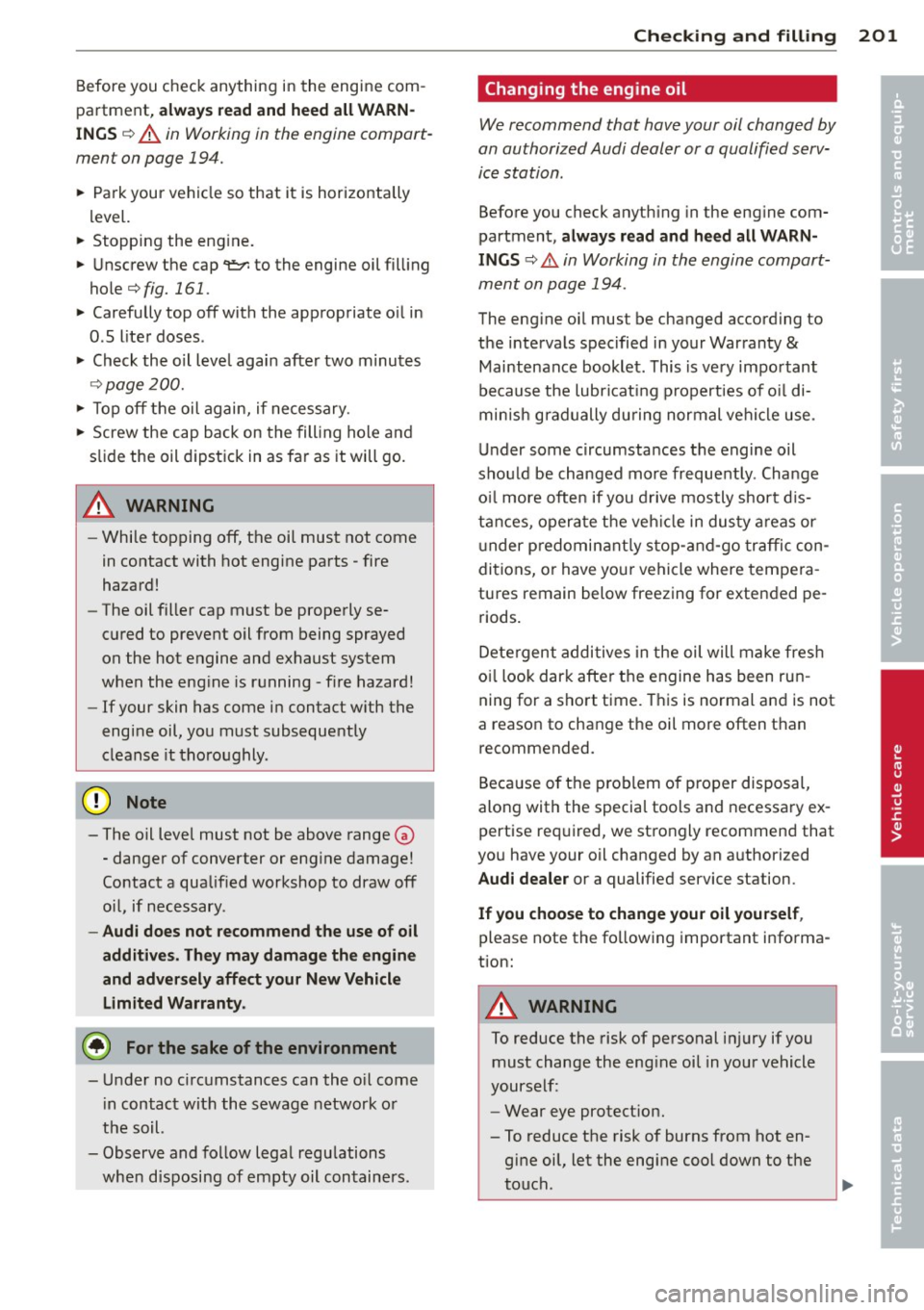
Before you check anything in the engine com
partment,
always r ead and heed all W ARN
ING S
¢ A in Working in the engine compart
ment on page 194.
.. Park your vehicle so that it is horizontally
level.
.. Stopping the eng ine.
.. Unscrew the cap
«t=;,. to the engine oil fill ing
hole
¢fig. 161 .
.. Carefully top off with the appropriate o il in
0 .5 lite r doses.
.,. Check the o il leve l again after two minutes
¢ page 200.
.,. Top off the oil again, if necessary.
.. Screw the cap back on the filling hole and
slide the oil dipstick in as far as it will go.
A WARNING
- While topping off, the oil must not come
in contact with hot engine parts -fire
hazard!
- The oil filler cap must be properly se
c u red to prevent oil from being sprayed
on the hot engine and exhaust system
when the eng ine is running - fire hazard!
- If your skin has come in contact w ith the
engine oil, you must subsequently
cleanse it tho roughly .
(D Note
-The oil leve l must not be above range~
- danger of converter or eng ine damage!
Contact a qualified workshop to draw off
oi l, if necessary .
-Audi does not recommend the use of o il
add iti ve s. They may damag e the engine
and adve rsely affect you r New Vehicle
Limited Warranty .
@) For the sake of the environment
-Under no circumstances can the o il come
i n contact with the sewage network or
the soil.
- Observe and follow legal regu lations
when d isposing of empty oil containers.
Checkin g and fillin g 201
Changing the engine oil
We recommend that have your oil changed by
an authorized Audi dealer or a qualified serv
ice station .
Before you check anyth ing in the eng ine com
partment,
alw ays read and h eed all WARN
INGS ¢
A in Working in the engine compart
ment on page 194 .
The engine oil mus t be changed according to
the intervals spec ified in your Warranty
&
Maintenance booklet. This is very important
because the lubricat ing properties of o il di
min ish g radually du ring normal vehicle use .
Under some c ircumstances the engine oil
should be changed more frequent ly . Change
o il more ofte n if you drive mostly short d is
tan ces, opera te the veh icle in dus ty a reas or
u nder p redominant ly stop -and-go traffic con
ditions, or have you r vehicle where tempera
tures remain below freezing for extended pe
riods .
Dete rgent additives in the oil will make fres h
o il look dar k after t he engine has been run
ning for a sho rt time. T his is normal a nd is not
a reason to change the oil more often t han
recommended.
Because of the prob lem of p roper disposal,
along with the specia l tools and necessary ex
pertise req uired, we strongly recommend that
you have your oil changed by an authorized
Audi dealer or a qualified service station.
If you choo se to change your oil your self ,
please note the fo llowing important informa
tion:
A WARNING
To reduce the risk of personal injury if you must change the eng ine oil in your vehicle
yourself:
- Wear eye protect ion.
- To reduce the risk of burns from hot en-
gine oil, let the engine cool down to the
touch.
•
•